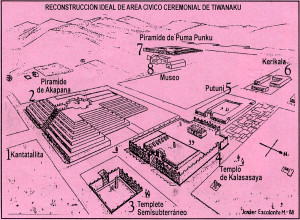Posnansky
Pumapunku *
 Pumapunku is a terraced earthen mound, faced with blocks and an important part of the Tiwanaku archaeological site on the Bolivian Altiplano. It has unique architectural features including the use of building blocks with up to 80 faces on them. The Tiwanaku site is pre-Inca and has given its earliest radiocarbon date as 536-600 AD and was in use until circa 1000 AD(a), which is a far cry from the flawed 12,000-15,000 BC date claimed by Posnansky(e)(f). Details of how these late dates were arrived at are available in a paper by Jason Yaeger and Alexei Vranich on the Academia.edu website(j).
Pumapunku is a terraced earthen mound, faced with blocks and an important part of the Tiwanaku archaeological site on the Bolivian Altiplano. It has unique architectural features including the use of building blocks with up to 80 faces on them. The Tiwanaku site is pre-Inca and has given its earliest radiocarbon date as 536-600 AD and was in use until circa 1000 AD(a), which is a far cry from the flawed 12,000-15,000 BC date claimed by Posnansky(e)(f). Details of how these late dates were arrived at are available in a paper by Jason Yaeger and Alexei Vranich on the Academia.edu website(j).
As with so many other enigmatic ancient sites, various members of the ‘lunatic fringe’ have attributed the construction at this location to either ancient astronauts or Atlanteans or an exotic combination of both, based on either over-fertilised imaginations or flawed data or again, both. Jason Colavito has written a critique of some of the more silly suggestions(b). In September 2024, Ancient Aliens revisited Puma Punku (S20.E20), recycling silly claims about extraterrestrial visitors. Once again, Colavito was obliged to put fingers to keyboard to review this latest episode(l).
Ancient astronaut advocate Von Däniken[1147.221] and Brien Foerster(d) among others have claimed that the stones of Pumapunku were composed of diorite, an exceptionally hard stone, which would have required a modern diamond-tipped drill to work it. The implication is that only Atlanteans with their advanced technology or extraterrestrials could have worked the stone with such precision.
Brien Foerster also published a paper on the Academia.edu website in Feb. 2023 in which he decries “The extraction, wanton destruction, and recycling of much of the Puma Punku site that can be easily seen in the small nearby town also called Tiwanaku, where many of the buildings, including the church, contain the telltale grey andesite blocks, with smooth flat surfaces, which clearly came from Puma Punku.” He also points out that while Tiwanaku has been declared a World Heritage Site by UNESCO, Puma Punku has received little attention(k).”
However, Colavito and Michael Heiser(c) have pointed out that this identification is untrue and that they were composed of the softer andesite and red sandstone. Apart from this, the Code of Hammurabi was incised on diorite, without Atlantean or extraterrestrial assistance, 2,000 years before the development of Pumapunku!
Joseph Davidovits who controversially proposed that Giza’s Great Pyramid stones had been cast rather than carved has also claimed that other well-known structures had been created in a similar manner, such as at Tiwanaku and Puma Punku in Peru(g) and Easter Island(h).
Javier Escalante Moscoso is an architect with a degree in archaeology who has extensively excavated and surveyed the Tiwanaku monuments. (see map above).
A fully illustrated guide to the monuments of Tiwanaku/Puma Punku is an excellent introduction to the site including a map by Moscoso(i).
(a) https://skeptoid.com/episodes/4202
(b) https://www.jasoncolavito.com/blog/review-of-in-search-of-aliens-s01e07-the-mystery-of-puma-punku
(c) See: https://atlantipedia.ie/samples/archive-2803/
(d) https://hiddenincatours.com/posts/videos/#!/keyword_filter=Puma%20Punku (now password protected) *
(e) The age of Tiwanaku (Tiahuanaco) Site, Bolivia (archive.org)
(f) https://www.mail-archive.com/ctrl@listserv.aol.com/msg62910.html
(g) https://www.geopolymer.org/archaeology/tiahuanaco-monuments-tiwanaku-pumapunku-bolivia/
(h) https://www.geopolymer.org/library/video/they-came-from-america-to-build-easter-island/
(i) Tiwanaku, the mysterious pre-Inca capital – mapaymochila.es
(k) (99+) The Enduring Enigma Of Puma Punku in Bolivia | Brien Foerster – Academia.edu
(l) https://www.jasoncolavito.com/blog/review-of-ancient-aliens-s20e20-resurrecting-puma-punku
Survivors
Survivors of the Atlantean destruction are a reasonable expectation given the extent of its influence as described by Plato. The fact that its rulers only met every few years suggests a geographical spread that must have left some, if not most, of the confederation intact, irrespective of the location of the earthquake’s epicentre. Some have proposed that survivors migrated to an extensive range of locations such as Egypt, the Middle East and the Americas, but offer little to substantiate their claims apart from the widely dispersed flood myths that are most likely to have arisen following the melting of glaciers at the end of the last Ice Age.
Sanchuniathon refers to the original kings of Egypt calling them ‘Aleteans’. Albert Slosman claims[551] that survivors from Atlantis had migrated to Egypt. The archaeologist, Marcelle Weissen-Szumianska, in a 1965 book, Origines Atlantiques des Anciens Egyptiens [837], maintained that the pre-pharaonic Egyptians originated in Atlantis, which had been situated in Morocco! Others suggest that Egypt was an Atlantean colony.
Egerton Sykes proposed that the Tuatha deDanaan were refugees from Atlantis in his 1949 edition of Donnelly’s Atlantis. Sean Welsh is one of several who have labelled the Sea Peoples as Atlantean refugees.
All the suggestions put forward are either pure speculation, invention or allegedly derived from some psychic source. W. Scott-Eliot claimed [543] that refugees from an Atlantic Atlantis fled westward to Mexico and became the Toltecs and eastward and built Stonehenge ln Britain! While other European cultures have also had Atlantean roots attributed to them, the most frequently named are the great civilisations of Central and South America – Aztec, Mayan and Incan. Posnansky went as far as to suggest that Tiwanaku in the Andes was built by Nordic refugees from Atlantis! Proof, however, is lacking in all cases.
